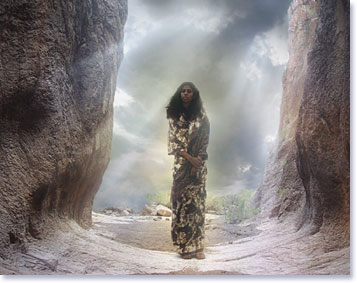 |
Zachary Humway is a familiar name to anyone who has been around the Caligari website for the last few years. His images frequently show up in the monthly gallery, quite often as winners too.
Zachary’s repeated presence in the gallery is thanks in part to his skill at making artistic images, with an almost painted look to them. With no trace of the « cold » look that can often haunt a rendered image, Zachary sets out to tell stories and impart messages with his artwork.
Interested in how he could create so many great pieces, we interviewed him to find out more about the man and his art!
|
 |
|
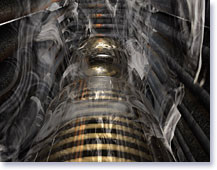
|
|
Discovering 3D
Everyone is different in how they discover 3D and how they can
use it.
« I was forced into computer graphics when I went to work for KAIT-TV in Jonesboro, AR in 1998. » Zachary told us. « I had very little experience but quickly learned what exactly Photoshop was and what it meant for television producers. »
« I used it primarily for full-screen CG. A small gig I had at the time was a 30 second spot called ‘What’s the Word.’ It was a commercial of sorts that picked a ‘word of the week,’ defined it and gave meaning to it. »
« One day I didn’t have time to go out and shoot for the program, so I opted for an in-house production. I stumbled onto Bryce 4 on the graphics computer and started whipping out animations within an hour or two. It left a very memorable impression on me…one that would come back to me about 2 years afterwards when I saw that same software in a catalogue. » |
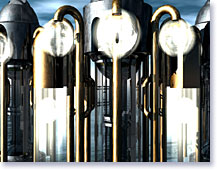

|
A Matter of Style
Given his unique and almost painterly-style, we wondered if Zachary had ever rendered ‘conventional’ 3D images that most people start with.
« We all have to start somewhere. I remember the bulk of my earlier works were simply experimental…and to a degree they still are. We learn something new with every piece. In my earlier works I was fascinated and compelled to produce typical images of ‘reflective spheres’ and ‘water plains.’ I think it’s necessary as a form of 3d evolution: To feel and express that way light reacts with our world with the simplest of expressions. So, I did several relfective primitives and odd-shaped terrains in the beginning. I think it’s imperative for any 3d artist to begin that way and follow the inspiration up! »
 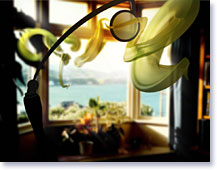 |
The Tools and Techniques
Thinking about that unique style that he achieves, we asked Zachary if he had any tips for getting away from the ‘cold’ look of many renderings, to the warm look of his works.
« Style is extremely important to me as an artist. I think we all struggle at some time or another with « making the piece our own. » In order to give each of my pieces a « hands-on » feel, I incorporate a good deal of matte painting in Photoshop. Put shortly, I apply layers over each render and do some good, old fashioned painting. Depending on what I want to bring out, I’ll use different blending modes: For atmospheric (volumetric) lighting effects, I’ll use « soft light. » For shadows, « multiply. » I also use « overlay » liberally to help unify colors/palettes as well as enhancing lighting in the scene. It’s been described as « painterly, » and that’s just what it is!
At heart, I’m a lover of light and atmosphere, and I adore how it can react with the 3d world you’ve created for yourself. My object is usually not one of photorealism, but a sense of « Hyper-reality. » I think it’s that surrealism that makes it all so much more interesting. » |
Where Does It All Come From?
With some insight into the ‘how’, now we asked Zachary about the ‘why’ – what drives him and inspires him when creating his artwork?
« Inspiration is an absolute MUST nowadays. In my past, I could simply sit down and do any little thing my heart desired. As it stands today, I absolutely MUST have something that ‘needs to be said.’ All of us, as 3d artists, are fascinated/inspired to exceed our grasp with each new render. For me, it’s often been the idea of expressing a universal thought with a single snapshot from my brain. »
» This challenge keeps me focused with every piece I develop. This is also the reason I never save models or specifically created textures from any given artpiece. I believe each should stand alone…and that is why I take great pride in deleting all project files after each piece is completed! Like us, I feel ideas come from dust and return to dust. The buddhists call this intemperance…I call it ‘the condition of being.’ »
|
A Cage, Or A Freedom?
It would seem that 3D could be quite limiting for someone with Zachary’s artistic approach. Does he find he has to fight against the CAD, design or technical illustration mindset and toolset in much of 3D?
« To be perfectly honest, I’ve always wanted to be an artist; However, I faced the dilemma early on that I could not draw, sculpt, paint or even take a photograph to save my life. One thing I could do, however, is 3d modeling. »
« I’m deeply concerned that society as a whole views computer art as shallow, or simply ‘not art at all.’ There’s a collective notion that the computer does all the art, and the artist simply boots up the computer and lets it work for them. Of course, we all know this to be false. As far as technique, expression and form, the digital artist is every bit as adapt as Dali or Kahlo in his/her own right. I see digital art, respectively, as equal as any medium…and only a select few can truly make it shine. »
Adding the Fourth Dimension
« I sincerely try to avoid animating for the simple fact that
expressing a particular thought is more challenging in a single snapshot than in an animation. » Zachary told us, when we asked if he had ever thought of making an animation.
« Edgar Allen Poe believed that a great literary piece should be read in a |


|
single sitting. Likewise, I try to produce an image that is stimulating enough to burn itself in the viewers brain and curious enough to linger and cause change. »
The Man Behind The Art
« I grew up with bi-polar disorder and a high I.Q. (baggage enough for anyone). I had a horrible tendency to see much more than anyone else around me. Frustrating as it was, I had everything to share, and no one to share it with. » Zachary said when we asked about himself and his life.
» I resorted to writing at an early age. Because of my artistic limitations, I could not express myself fully in the way I truly wanted to. Still today, digital art remains more a form of therapy than a hobby. I could no more live without breathing than to sustain without the craft. »
|
Changes
We wondered what Zachary saw as changing in 3D art in the future.
« I see 3d art changing dramatically in the next 10 years. I think new modeling tools, coupled with enhanced hardware specs will get 3d artists closer to reproducting their worlds easier and with less hassle than ever. I think improvements in texture mapping, particle effects, radiosity and fractal generation will yield more photorealistic environments with greater ease and very STIMULATING results in a fraction of the time it takes us nowadays. Personally, I can’t wait! »
2D Or Not 2D
« The only time I work strictly in 2D than 3D is when I’m cranking out a brochure or postcard for our business. » Zachary replied when we asked if he worked in 2D at all. « It’s always fun and lighthearted for me to endeavor on these projects…after all, it’s just business, not personal 😛 »
« Now, I can’t say I do much work as far as traditional 2D rendering. Like I said before, I can’t draw a one-armed stickfigure to save my life. The limit to my 2D work is strictly the matte painting I apply to each render. » |


|
 |
A Thousand Words
Zachary had mentioned his strong literary background, so we asked how this affected his artwork.
« Because my second major was English, a good deal of literary devices color each and every one of my artworks. I’m steeped in the tradition of symbolism, foreshadowing and storytelling in general. To the best of my ability, I try to incorporate that same tradition into every thing I produce. The quickest way to realize this is to examine the title of each piece and ask ‘how does it relate to what I am seeing?’ « |
If Then Else
It’s clear that 3D plays a fundamental and important role in Zachary’s life. What if there was no 3D software though, how would he express himself then?
« If I didn’t have the ability to express myself in 3d, I would likely revert back to writing. Writing is the simplest, most direct way of communicating an idea. I really feel that all digital artists, at heart, have something to say in each and every render. »
« This is our most fundamental link: WE have something to say. »
|
The Best Advice
With this master renderer answering our questions, we had to take the opportunity to get some tips and pointers! What was his most important piece of advice that he would give to other artists?
« My advice to others would be – ‘have fun.’ The worst pieces I’ve ever produced are the ones I’ve tried too dang hard on! »
« Above all, have fun…everything else is secondary. » |
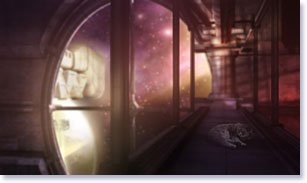
|

|